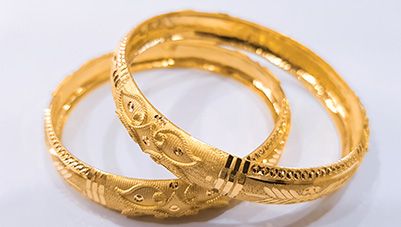Rs. 5,000 - Rs. 2 crore
To find the nearest gold loan branch,
Enter phone and OTP | Check amount you can get | Apply for quick funds
Understanding yellow gold and rose gold
Understanding the difference between yellow gold and rose gold can help you pick the right jewellery for your style. Yellow gold, with its rich and classic glow, is deeply tied to tradition and timeless elegance. On the other hand, rose gold, created by blending gold with copper, has a soft pinkish tone that feels modern and romantic. While yellow gold is known for durability and heritage appeal, rose gold offers a unique, trendy twist that stands out. By looking at their composition, style, and affordability, you can decide which one matches your personality and occasion best.
What is yellow gold?
Yellow gold is the most traditional and natural form of gold used in jewellery. It is created by mixing pure gold with alloys like copper and silver to enhance its strength and durability. Known for its rich, warm hue, yellow gold symbolises timeless elegance and is widely used in cultural and religious ornaments in India. It is available in different purity levels, such as 22 karats, 18 karats, and 14 karats, with higher karatage indicating greater gold content. Yellow gold’s classic appeal makes it a popular choice for traditional jewellery and wedding bands. Its warm tone complements all skin types, adding to its universal charm. Buyers in India prefer yellow gold for its cultural significance, ease of resale, and consistent demand. Ensuring its purity through hallmarking is essential when purchasing yellow gold to guarantee quality and authenticity.
What is rose gold?
Rose gold is a modern and elegant variation of gold, known for its pinkish hue. It is created by alloying pure gold with copper and sometimes a small amount of silver. The higher copper content gives rose gold its distinctive reddish-pink colour. Available in different karatage levels, such as 18 karats and 14 karats, rose gold balances durability with a soft, romantic aesthetic. It has become a popular choice for contemporary jewellery, including engagement rings, bracelets, and fashion pieces. Rose gold’s unique colour complements a wide range of gemstones, enhancing its versatility in design. Its warm, rosy tone flatters various skin tones, adding a touch of sophistication to modern jewellery collections. Buyers appreciate rose gold for its trendy appeal, durability, and ability to retain its colour over time. As with other types of gold, ensuring its hallmark certification is vital for authenticity.
Get the value your gold deserves. Check your gold loan eligibility and see how much you can avail based on purity and weight.
Yellow gold vs rose gold: Comparison
| Feature | Yellow Gold | Rose Gold |
| Composition | Pure gold mixed with copper and silver alloys | Pure gold mixed with copper and sometimes silver |
| Colour | Warm, rich golden tone | Pinkish-red hue |
| Purity Levels | Commonly available in 22K, 18K, 14K | Commonly available in 18K, 14K |
| Durability | Softer than rose gold; higher karatage is less durable | More durable due to higher copper content |
| Popularity | Traditional, timeless appeal | Modern, trendy aesthetic |
| Resale Value | Higher resale value | Moderate resale value |
| Best Use | Cultural and wedding jewellery | Contemporary designs and fashion jewellery |
Durability and maintenance: Which is better?
When comparing yellow gold and rose gold for durability and maintenance, their composition plays a significant role. Yellow gold, particularly in higher karatage, is softer and more prone to scratches. Lower karatage options like 18 karats or 14 karats are sturdier due to added alloys. Rose gold, with its higher copper content, is naturally more durable and resistant to wear. However, both types require regular cleaning to maintain their shine. Using a soft cloth and mild soap can effectively remove tarnish. Proper storage, such as keeping jewellery in a fabric-lined box, prevents scratches. For buyers prioritising gold purity, yellow gold is more traditional, but rose gold offers better longevity. Maintenance needs for both types are minimal but consistent care ensures they retain their appeal over time.
Yellow gold or rose gold: Which is more affordable?
Affordability depends on the karatage and composition of yellow gold and rose gold. Yellow gold, with higher gold content in 22 karats or 24 karats, is generally more expensive due to its purity. Rose gold, often available in 18 karats or 14 karats, contains a higher proportion of copper, making it more cost-effective. However, intricate designs and craftsmanship can influence the final price of both types. Rose gold’s affordability makes it a popular choice for budget-conscious buyers seeking stylish jewellery. In India, yellow gold retains a higher resale value, which may offset its initial cost for investment purposes. For buyers considering affordability, rose gold offers a modern alternative, while yellow gold remains a classic option with cultural significance.
Style and popularity of yellow gold vs rose gold
Yellow gold has long been associated with traditional jewellery, symbolising timeless elegance and cultural significance. It is a staple choice for weddings, religious ceremonies, and heirloom pieces. Rose gold, on the other hand, has gained popularity in contemporary jewellery for its unique, romantic hue. Its modern appeal makes it a favourite for engagement rings, bracelets, and minimalist designs. While yellow gold complements all skin tones with its warm tone, rose gold’s pinkish-red colour flatters a wide range of complexions. The choice between the two often depends on personal style, occasion, and jewellery trends. Both options have their unique charm, catering to different preferences and aesthetic sensibilities.
Wondering how much you can borrow on your gold? Just check your gold loan eligibility—it takes seconds and minimal paperwork!
How to choose between yellow gold and rose gold?
Choosing between yellow gold and rose gold depends on factors such as style, durability, and purpose. Yellow gold is ideal for traditional jewellery and holds higher cultural and sentimental value, making it suitable for weddings and family heirlooms. Rose gold, with its contemporary aesthetic, appeals to buyers looking for trendy, modern designs. Durability also plays a role; rose gold is more resistant to wear due to its copper content. Buyers prioritising gold purity may prefer yellow gold, while those seeking affordability and uniqueness might opt for rose gold. Consider the occasion, personal style, and budget to make an informed decision.
Note: Bajaj Finance does not provide gold loans against rose gold jewellery.
Impact of yellow gold and rose gold on gold loan
Yellow gold and rose gold impact a gold loan differently due to their composition and value. Yellow gold, especially in higher karatage like 22 karats, offers a higher loan-to-value ratio because of its greater purity. Rose gold, with its lower gold content and higher alloy composition, may result in a lower valuation. Gold loan eligibility for loans depends on factors such as purity, weight, and hallmark certification. Bajaj Finance considers hallmarked gold for accurate valuation, ensuring transparency and competitive loan amounts. Borrowers should prioritise certified gold to meet eligibility criteria and secure optimal loan benefits.
Please note, Bajaj Finance does not accept rose gold as collateral for gold loan.
Ready to unlock the value of your gold? Apply for Bajaj Finserv Gold Loan today.
Related Articles
Disclaimer
Bajaj Finance Limited has the sole and absolute discretion, without assigning any reason to accept or reject any application. Terms and conditions apply*.
For customer support, call Personal Loan IVR: 7757 000 000









 Personal Loan
Personal Loan Check Eligibility
Check Eligibility Salaried Personal Loan
Salaried Personal Loan EMI Calculator
EMI Calculator Account Aggregator
Account Aggregator Credit Pulse Report
Credit Pulse Report
 Deals starting @99
Deals starting @99 Min. 50% off
Min. 50% off
 Bajaj Pay
Bajaj Pay Wallet to Bank
Wallet to Bank
 Easy EMI Loan
Easy EMI Loan Savings Offer
Savings Offer Smartphones
Smartphones Led TVs
Led TVs Washing Machines
Washing Machines Laptops
Laptops Refrigerators
Refrigerators Air Conditioner
Air Conditioner Air Coolers
Air Coolers
 Loan Against Shares
Loan Against Shares Loan Against Mutual Funds
Loan Against Mutual Funds Loan Against Insurance Policy
Loan Against Insurance Policy ESOP Financing
ESOP Financing Easy EMI Loan
Easy EMI Loan Two-wheeler Loan
Two-wheeler Loan Loan for Lawyer
Loan for Lawyer Industrial Equipment Finance
Industrial Equipment Finance Industrial Equipment Balance Transfer
Industrial Equipment Balance Transfer Industrial Equipment Refinance
Industrial Equipment Refinance Personal Loan Branch Locator
Personal Loan Branch Locator Used Tractor Loan
Used Tractor Loan Loan Against Tractor
Loan Against Tractor Tractor Loan Balance Transfer
Tractor Loan Balance Transfer Flexi
Flexi View All
View All
 Two-wheeler Loan
Two-wheeler Loan Bike
Bike Scooter
Scooter Electric Vehicle
Electric Vehicle Best Sellers
Best Sellers Popular Brands
Popular Brands

 Trading Account
Trading Account Open Demat Account
Open Demat Account Margin Trading Financing
Margin Trading Financing Share Market
Share Market Invest in IPO
Invest in IPO All stocks
All stocks Top gainers
Top gainers Top losers
Top losers 52 week high
52 week high 52 week low
52 week low Loan against shares
Loan against shares
 Home Loan
Home Loan Transfer your existing Home loan
Transfer your existing Home loan Loan against Property
Loan against Property Home Loan for Salaried
Home Loan for Salaried Home loan for self employed
Home loan for self employed Loan Against Property Balance Transfer
Loan Against Property Balance Transfer Home Loan EMI Calculator
Home Loan EMI Calculator Home Loan eligibility calculator
Home Loan eligibility calculator Home Loan balance transfer
Home Loan balance transfer View All
View All
 Term Life Insurance
Term Life Insurance ULIP Plan
ULIP Plan Savings Plan
Savings Plan Family Insurance
Family Insurance Senior Citizen Health Insurance
Senior Citizen Health Insurance Critical Illness Insurance
Critical Illness Insurance Child Health Insurance
Child Health Insurance Pregnancy and Maternity Health Insurance
Pregnancy and Maternity Health Insurance Individual Health Insurance
Individual Health Insurance Low Income Health Insurance
Low Income Health Insurance Student Health Insurance
Student Health Insurance Group Health Insurance
Group Health Insurance Retirement Plans
Retirement Plans Child Plans
Child Plans Investment Plans
Investment Plans
 Business Loan
Business Loan Secured Business Loan
Secured Business Loan Loan against property
Loan against property Loans against property balance transfer
Loans against property balance transfer Loan against shares
Loan against shares Home Loan
Home Loan Loans against mutual funds
Loans against mutual funds Loan against bonds
Loan against bonds Loan against insurance policy
Loan against insurance policy
 Apply for Gold Loan
Apply for Gold Loan Transfer your Gold Loan with Us
Transfer your Gold Loan with Us Gold Loan Branch Locator
Gold Loan Branch Locator
 ULIP Plan
ULIP Plan Savings Plan
Savings Plan Retirement Plans
Retirement Plans Child Plans
Child Plans Free Demat Account
Free Demat Account Invest in Stocks
Invest in Stocks Invest in IPO
Invest in IPO Margin Trading Facility
Margin Trading Facility Fixed Deposit Branch Locator
Fixed Deposit Branch Locator
 Check your Credit Score
Check your Credit Score
 New Car Loan
New Car Loan Used Car Loan
Used Car Loan Loan Against Car
Loan Against Car Car Loan Balance Transfer and Top-up
Car Loan Balance Transfer and Top-up My Garage
My Garage
 Get Bajaj Prime
Get Bajaj Prime
 Mobiles on EMI
Mobiles on EMI Electronics on EMI Offer
Electronics on EMI Offer  Iphone on EMI
Iphone on EMI LED TV on EMI
LED TV on EMI Refrigerator on EMI
Refrigerator on EMI Laptop on EMI
Laptop on EMI Kitchen appliances on EMI
Kitchen appliances on EMI Washing machines
Washing machines
 Personal Loan EMI Calculator
Personal Loan EMI Calculator Personal Loan Eligibility Calculator
Personal Loan Eligibility Calculator Home Loan EMI Calculator
Home Loan EMI Calculator Home Loan Eligibility Calculator
Home Loan Eligibility Calculator Good & Service Tax (GST) Calculator
Good & Service Tax (GST) Calculator Flexi Day Wise Interest Calculator
Flexi Day Wise Interest Calculator Flexi Transaction Calculator
Flexi Transaction Calculator Secured Business Loan Eligibility Calculator
Secured Business Loan Eligibility Calculator Fixed Deposits Interest Calculator
Fixed Deposits Interest Calculator Two wheeler Loan EMI Calculator
Two wheeler Loan EMI Calculator New Car Loan EMI Calculator
New Car Loan EMI Calculator Used Car Loan EMI Calculator
Used Car Loan EMI Calculator All Calculator
All Calculator Used Tractor Loan EMI Calculator
Used Tractor Loan EMI Calculator
 Hot Deals
Hot Deals Clearance Sale
Clearance Sale Kitchen Appliances
Kitchen Appliances Tyres
Tyres Camera & Accessories
Camera & Accessories Mattresses
Mattresses Furniture
Furniture Watches
Watches Music & Audio
Music & Audio Cycles
Cycles Mixer & Grinder
Mixer & Grinder Luggage & Travel
Luggage & Travel Fitness Equipment
Fitness Equipment Fans
Fans
 Personal Loan for Doctors
Personal Loan for Doctors Business loan for Doctors
Business loan for Doctors Home Loan
Home Loan Secured Business Loan
Secured Business Loan Loan against property
Loan against property Secured Business Loan Balance Transfer
Secured Business Loan Balance Transfer Loan against share
Loan against share Gold Loan
Gold Loan Medical Equipment Finance
Medical Equipment Finance
 Smart Hub
Smart Hub ITR Service
ITR Service Digi Sarkar
Digi Sarkar
 Savings Offer
Savings Offer Easy EMI
Easy EMI Offer World
Offer World 1 EMI OFF
1 EMI OFF New Launches
New Launches Zero Down Payment
Zero Down Payment Clearance Sale
Clearance Sale Bajaj Mall Sale
Bajaj Mall Sale
 Mobiles under ₹20,000
Mobiles under ₹20,000 Mobiles under ₹25,000
Mobiles under ₹25,000 Mobiles under ₹30,000
Mobiles under ₹30,000 Mobiles under ₹35,000
Mobiles under ₹35,000 Mobiles under ₹40,000
Mobiles under ₹40,000 Mobiles under ₹50,000
Mobiles under ₹50,000
 Articles
Articles
 Overdue Payments
Overdue Payments Other Payments
Other Payments
 Document Center
Document Center Bank details & Documents
Bank details & Documents Tax Invoice Certificate
Tax Invoice Certificate
 Do Not Call Service
Do Not Call Service
 Hamara Mall Orders
Hamara Mall Orders

 Fixed Deposit (IFA) Partner
Fixed Deposit (IFA) Partner Loan (DSA) Partner
Loan (DSA) Partner Debt Management Partner
Debt Management Partner EMI Network Partner
EMI Network Partner Became a Merchant
Became a Merchant Partner Sign-in
Partner Sign-in
 Trade directly with your Demat A/c
Trade directly with your Demat A/c ITR
ITR My Garage
My Garage
 Live Videos - Beta
Live Videos - Beta
 Savings Offer
Savings Offer Smartphones
Smartphones LED TVs
LED TVs Washing Machines
Washing Machines Laptops
Laptops Refrigerators
Refrigerators Air Conditioners
Air Conditioners Air Coolers
Air Coolers Water Purifiers
Water Purifiers Tablets
Tablets Kitchen Appliances
Kitchen Appliances Mattresses
Mattresses Furniture
Furniture Music and Audio
Music and Audio Cameras & Accessories
Cameras & Accessories Cycle
Cycle Watches
Watches Tyres
Tyres Luggage & Travel
Luggage & Travel Fitness Equipment
Fitness Equipment Tractor
Tractor Easy EMI Loan
Easy EMI Loan
 vivo Mobiles
vivo Mobiles OPPO Mobiles
OPPO Mobiles Xiaomi Mobiles
Xiaomi Mobiles Sony LED TVs
Sony LED TVs Samsung LED TVs
Samsung LED TVs LG LED TVs
LG LED TVs Haier LED TVs
Haier LED TVs Godrej Refrigerators
Godrej Refrigerators Voltas Washing Machines
Voltas Washing Machines
 New Tractor Loan
New Tractor Loan Used Tractor Loan
Used Tractor Loan Loan Against Tractor
Loan Against Tractor Tractor Loan Balance Transfer
Tractor Loan Balance Transfer
 New Car Loan
New Car Loan New Cars Under ₹10 Lakh
New Cars Under ₹10 Lakh New Cars – ₹10–₹15 Lakh
New Cars – ₹10–₹15 Lakh New Cars – ₹15–₹20 Lakh
New Cars – ₹15–₹20 Lakh New Cars – ₹20–₹25 Lakh
New Cars – ₹20–₹25 Lakh New Car Brands
New Car Brands Petrol – New Cars
Petrol – New Cars Diesel – New Cars
Diesel – New Cars Electric – New Cars
Electric – New Cars CNG – New Cars
CNG – New Cars Hybrid – New Cars
Hybrid – New Cars











